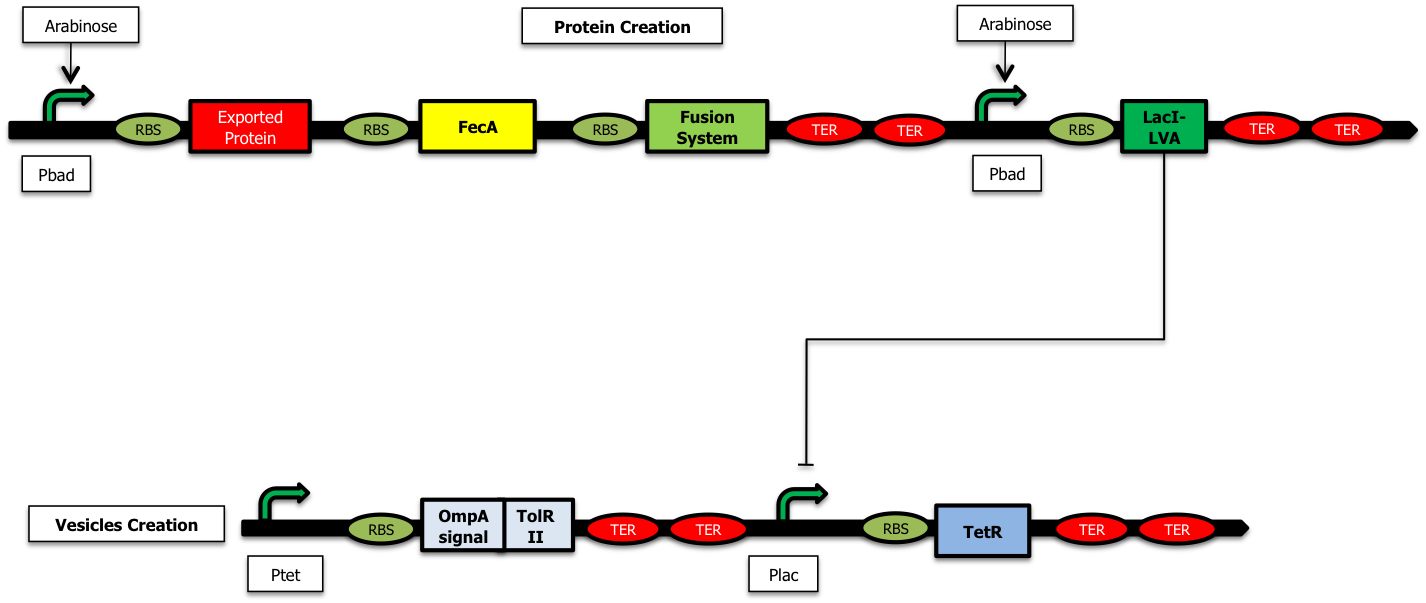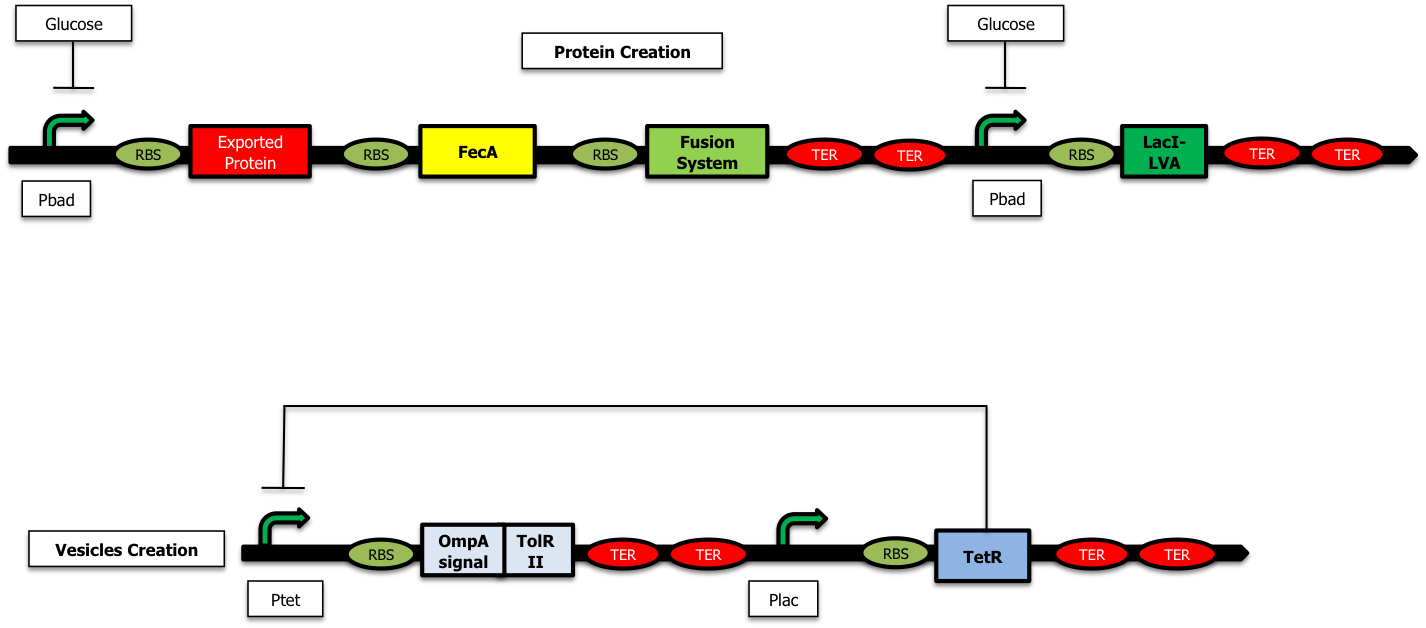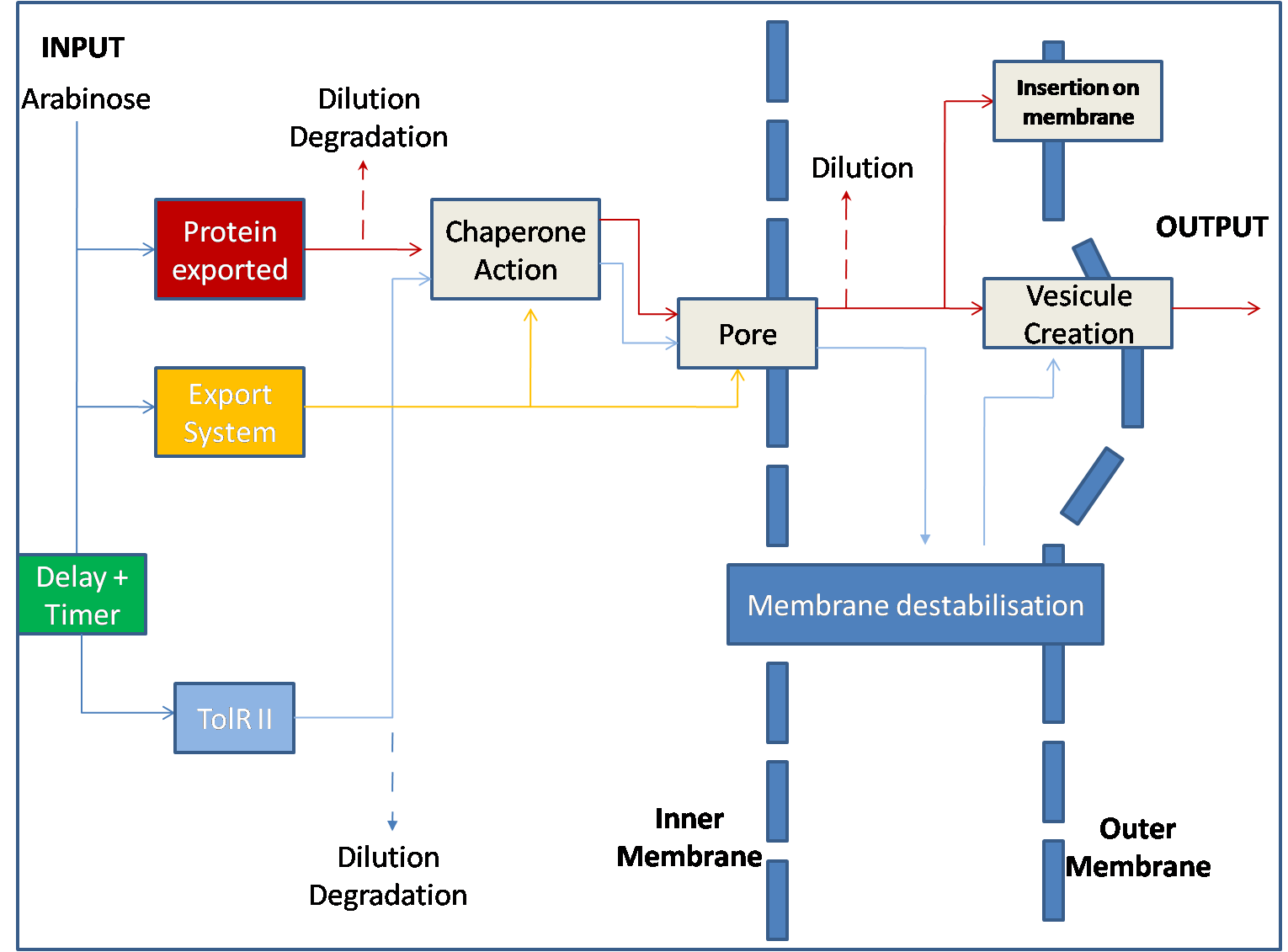Team:Paris/Project
From 2009.igem.org
Cha.olivier (Talk | contribs) (→Overall project: Message in a bubble) |
Cha.olivier (Talk | contribs) (→Overall project: Message in a bubble) |
||
| Line 21: | Line 21: | ||
So, we decided to improve bacterial communication thanks to the vesicles formation process. In this direction our engineered communication platform consists in controlling OMV production by destabilizing membrane integrity through over-expression of specific periplasmic proteins of the Tol/Pal system. The over-production of TolR (a major protein of the Tol/Pal system which ensure the membrane integrity) has to be controled to avoid the bacteria death. | So, we decided to improve bacterial communication thanks to the vesicles formation process. In this direction our engineered communication platform consists in controlling OMV production by destabilizing membrane integrity through over-expression of specific periplasmic proteins of the Tol/Pal system. The over-production of TolR (a major protein of the Tol/Pal system which ensure the membrane integrity) has to be controled to avoid the bacteria death. | ||
Another important key point of our project is to obtain a delay between the production of protein of interest and the vesicle formation, to be sure that the produced vesicles carried the different protein required for the recognition of the target bacteria and thus the one essential for the signal transduction. | Another important key point of our project is to obtain a delay between the production of protein of interest and the vesicle formation, to be sure that the produced vesicles carried the different protein required for the recognition of the target bacteria and thus the one essential for the signal transduction. | ||
| + | |||
| + | |||
| + | In order to control and modulate message content, we used fusions with OmpA signal sequence and the ClyA hemolysin as delivery tags. OmpA is a major protein of the external membrane of ''E.Coli'' and is also localize on OMVs. In this direction OmpA seems to be appropriate to deliver a specific protein to the outer membrane and, by consequence into vesicles. As OmpA, ClyA is an interesting way to explore to send protein to the external membrane. | ||
| + | |||
| + | |||
| + | To control the communication between the donnor and the receiver a targeting system was developed. This system is based on the outer-membrane expression of Jun/Fos leucine zippers to control the vesicle flux between donor and recipient cells. Jun was mutated into its leucine zipper-motif to abolished the homodimer formation but to allow the development of heterodimer with Fos. To express these protein to the outer membrane of bacteria, they were merged with AIDA autotransporter. In this direction, the direction and the specificity of communication is controled. | ||
| + | |||
Revision as of 19:38, 21 October 2009
iGEM > Paris > Home > OMV Project
Contents |
Overall project: Message in a bubble
Message in a Bubble: cell-cell communication using vesicles.
Bacterial communication:
Bacteria communicate with another one using chemical signal molecules. As in higher organisms, the information supplied by these molecules is critical for synchronizing the activities of large groups of cells. In bacteria, chemical communication involves producing, releasing, detecting, and responding to small hormone-like molecules (called acylhomoserine lactones, AHL). This process, also known as quorum sensing, allows bacteria to monitor the environment for other bacteria and to alter behavior on a population-wide scale in response to changes in the number and/or species present in a community.
AHL molecules are broken down by other bacteria, and some AHL signals are poorly soluble in water, so they cannot travel far in an aqueous environment (this factor limits their potential as a long communication signals).
Growing gram-negative bacteria release vesicles from their outer membranes as a means of delivering toxins to host cells and other bacteria. This mecanism is conserved among Gram-negative bacteria. The vesicles consist of a lipid bilayer surrounding an aqueous core and they can therefore transport lipid-soluble toxins (lipopolysaccharide endotoxin) on their surface and protein toxins in their core. They release their poisonous cargo by fusing with the lipid bilayer of target cells.
So, we decided to improve bacterial communication thanks to the vesicles formation process. In this direction our engineered communication platform consists in controlling OMV production by destabilizing membrane integrity through over-expression of specific periplasmic proteins of the Tol/Pal system. The over-production of TolR (a major protein of the Tol/Pal system which ensure the membrane integrity) has to be controled to avoid the bacteria death. Another important key point of our project is to obtain a delay between the production of protein of interest and the vesicle formation, to be sure that the produced vesicles carried the different protein required for the recognition of the target bacteria and thus the one essential for the signal transduction.
In order to control and modulate message content, we used fusions with OmpA signal sequence and the ClyA hemolysin as delivery tags. OmpA is a major protein of the external membrane of E.Coli and is also localize on OMVs. In this direction OmpA seems to be appropriate to deliver a specific protein to the outer membrane and, by consequence into vesicles. As OmpA, ClyA is an interesting way to explore to send protein to the external membrane.
To control the communication between the donnor and the receiver a targeting system was developed. This system is based on the outer-membrane expression of Jun/Fos leucine zippers to control the vesicle flux between donor and recipient cells. Jun was mutated into its leucine zipper-motif to abolished the homodimer formation but to allow the development of heterodimer with Fos. To express these protein to the outer membrane of bacteria, they were merged with AIDA autotransporter. In this direction, the direction and the specificity of communication is controled.
A. Plasmid construction
Avant de parler des plasmides que vous avez voulu construire, il faut parler du système entier lui même. Et c'est bien ce que vous faites dans la suite en partie. L'implémentation sur des plasmides particuliers est un point technique qui vient après.
GC: tout a fait d'accord ! Il faut aussi mettre ici (ou juste au dessus) quelques generalités sur la communication en général et chez les bactos en particulier. Mettre l'accent sur les obstacles a la communication (taille des cellules, peu de systeme dedié...) et j'en profiterai pour faire une presentation simple des membranes qui est une forme de contrainte. Les membranes sont centrale dans ce projet et doivent etre presentée clairement et rapidement. Pour le moment, cela ce trouve dans la partie Tol/Pal et je pense que ça serait mieux ici).
En premier lieu faites un schéma, un diagramme du projet complet: production des proteines signal, système d'adressage de ces protéines vers la membraexterne, production des proteins pour l'émission de vésicules,production des vésicules, réception des vésicules, déclenchement d'un accusé de réception etc...
Un tel schéma peut être dynamique hyperliens vers les parties correspondantes. Ayez en vue le discours modulaire à différentes échelles des biobricks: niveau système, niveau device, niveau ADN... on ne parle des plasmides qu'au niveau inférieur.
The plasmid construction is divided into 2 functional modules :
- The emission system, which aims at producing vesicules.
- The reception system of the signal sent via the vesicules.
A.1. The emission system
To implement our vesicles emission project, we had to take several constrains into account. To put into place all the functionalities we needed, we designed 2 different plasmids as shown on the image below.
Writing the message: production of signaling proteins
First of all, before sending vesicles into the surrounding medium, we have to make sure that every molecule and protein that has to be inside the vesicles is already into place before the bacteria starts the creation of vesicles. In other words, the "emitting" bacteria must produce the proteins of interest, the export systems, the FecA proteins as well as the fusion mechanism before creating vesicles.
To create this delay between the creation of proteins and the production of vesicles, we designed a regulatory cascade consisting of the LacI and TetR repressors. The LacI biobrick is placed in the first plasmid, downstream the pBad promoter and once synthesized acts as a repressor on the pLac promoter. The pLac promoter in the second plasmid then stops expressing TetR. The ptet promoter is then no longer repressed and the creation of non functional TolR can start leading to the emission of vesicles.
Preparing the messenger: creation of the vesicles
As the creation of vesicles via the over-expression of TolR disturbs the membrane integrity and can create an important cell lysis, it appeared very important to find a way to avoid a long lasting expression of our TolR biobrick once the input signal is on (presence of arabinose in the medium).
To solve this problem, we decided to place a tag on the LacI protein to speed up its degradation. As a consequence, once the arabinose in the medium is depleted, LacI production stops and the remaining LacI is rapidly degraded. The production of TetR can resume and inhibit vesicle production.
- In presence of Arabinose, proteins of interest are created as well as vesicles :
- In the absence of arabinose, the pBad promoter is repressed and there is no production of proteins nor vesicles :
A more accurate description of the parts used at each step of the creation process (including links to the parts registry and references) can be found in the different subdivision of the project.
A.2. The reception system
A FAIRE RAPIDEMENT
B. Modeling overview
Cette image est pas mal. Et c'est quelque chose dans cet esprit qui devrait être tout au début pour présenter le système global de votre projet. Ce n'est pas seulement une image de modélisation.
Mais ce diagramme est à clarifier. Protein exported -> Exported "message" protein production Export system -> (il s'agit bien de l'addessage des protéines ci-dessus vers la membrane externe?) Addressing system of the message protein to the "bottle", sending the message to the bottle TolRIII -> Production of the message bootle (or of the envelope)
On ne comprend pas Chaperone Action. Ce diagramme doit être lisible pour comprendre les mécanismes, sans détails des molécules sous-jacentes. Il peut-être complété par un niveau plus détaillé, faisant apparaître la couche sous-jacente (les protéines particulières impliquées, les construction de plasmides, etc...)
Le même diagramme aussi pour la réception des signaux.
 "
"


